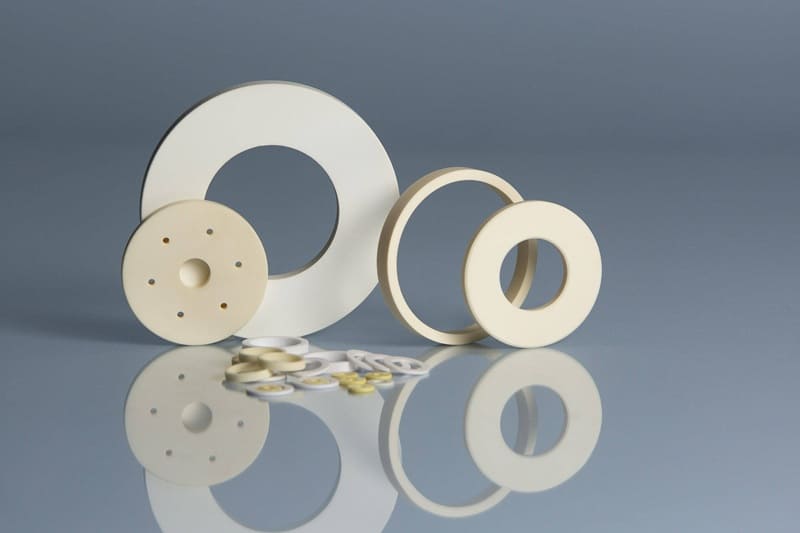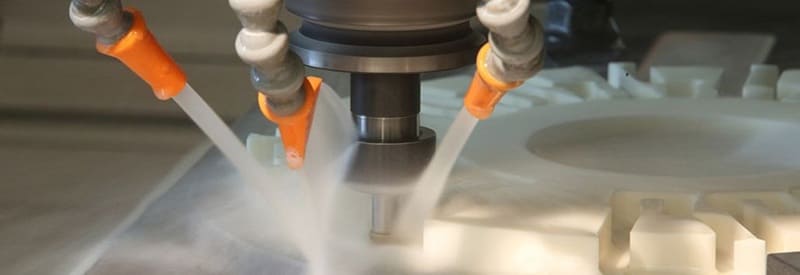How to Machine Alumina Ceramics Without Cracks?
Overview
Alumina ceramics are renowned for their exceptional hardness, wear resistance, and thermal stability, making them a preferred material in industries ranging from electronics to aerospace. These properties make alumina ceramics highly durable and ideal for demanding applications. However, despite their advantages, machining alumina ceramics can be challenging. The inherent brittleness of the material, combined with the high forces and thermal stresses involved during the machining process, can lead to cracks if not carefully managed. Therefore, understanding the causes of these cracks and implementing the right machining practices is essential for achieving high-quality results without compromising the integrity of the material.
At Advanced Ceramics Hub, we specialize in high-quality alumina ceramics, ensuring optimal performance for industrial and scientific applications.

What Are The Properties of Alumina Ceramics?
Mechanical Properties:
| Material | Unit | 95% Al2O3 | 96% Al2O3 | 99% Al2O3 | 99.5% Al2O3 | 99.7% Al2O3 | 99.95% Al2O3 |
| Density | g/cm3 | 3.7 | 3.7 | 3.85 | 3.9 | 3.95 | 3.98 |
| Bending Strength (20℃) | Mpa | 300 | 300 | 330 | 360 | 380 | 500-600 |
| Compressive Strength (20℃) | Mpa | 2000 | 2000 | 2000 | 2350 | 2000 | 3500 |
| Young’s Modulus (20℃) | Gpa | 270 | 275 | 370 | 370 | 380 | 400 |
| Fracture Toughness (20℃) | MPam½ | 3.5 | 3.5 | 4 | 4 | 4 | 4.5 |
| Poisson’s Ratio(20℃) | \ | 0.2 | 0.22 | 0.22 | — | 0.23 | 0.23 |
| Mohs Hardness(20℃) | HRA | 8.0-8.5 | 8.0-8.5 | 8.5-9.0 | 9.0 | 9.0-9.5 | 9.0-9.5 |
| Vickers Hardness (HV1) | kg/mm2 | 1600 | 1600 | 1600 | 1650 | 1750 | 1800 |
Thermal Properties:
| Material | Unit | 95% Al2O3 | 96% Al2O3 | 99% Al2O3 | 99.5% Al2O3 | 99.7% Al2O3 | 99.95% Al2O3 |
| Thermal Expansion Coefficient (25-300 ℃) | 10-6K-1 | 6.5 | 6.5 | 7.6 | 7.2 | 7.2 | 7.5 |
| Thermal Conductivity (20℃) | W/mk | 20 | 25 | 27.5 | 32 | 32 | 45 |
| Thermal Shock Resistance | △T·℃ | 200 | 200 | 200 | 250 | — | 400 |
| Specific Heat Capacity | J/g·k | — | — | 0.79 | 0.78 | 0.79 | 0.80 |
| Max Operating Temperature (Oxygen Condition) | ℃ | 1600 | 1600 | 1650 | 1650 | 1700 | 1750 |
Electrical Properties:
| Material | Unit | 95% Al2O3 | 96% Al2O3 | 99% Al2O3 | 99.5% Al2O3 | 99.7% Al2O3 | 99.95% Al2O3 |
| Volume Resistivity (20℃) | Ω·cm | 1014 | 1014 | 1014 | 1014 | 1014 | 1014 |
| Dielectric Strength | KV/mm | 10 | 10 | 10 | 15 | 15 | 16 |
| Dielectric Constant (1 MHz, 25℃) | \ | 9 | 9 | 9.1 | 9.9 | 9.9 | 9.9 |
| Dielectric Loss Tangent (1MHz, 20℃) | tanδ | 3*10-4 | 2*10-4 | 3*10-4 | 1*10-4 | 1*10-4 | 1*10-4 |
Looking for premium alumina ceramics? Explore Advanced Ceramics Hub’s selection.
What Are The Methods of Machining Alumina Ceramics?
The processing methods for alumina ceramics are diverse, ranging from traditional techniques like pressing, milling, and grinding to advanced technologies such as laser sintering and electrical discharge machining. These methods are chosen based on the desired shape, size, and precision to achieve optimal performance and results.
- Dry Pressing: A method where powder is compacted into a mold without the use of a liquid binder.
- Wet Pressing: Involves mixing ceramic powder with a binder and water, then pressing into molds.
- Injection Molding: A method where ceramic slurry is injected into a mold to form complex shapes.
- Isostatic Pressing: Ceramic powder is pressed uniformly from all directions using a liquid medium.
- Milling: A machining process to remove material from a ceramic piece using a rotating tool.
- Grinding: A finishing process used to achieve precise dimensions and smooth surfaces.
- Cutting: Using saws or lasers to cut ceramic materials into desired shapes.
- Laser Sintering: A process that uses a laser to fuse ceramic powder into a solid form layer by layer.
- Hot Pressing: Applying both heat and pressure to sinter the ceramic material, improving density and strength.
- Hot Isostatic Pressing: A high-temperature, high-pressure technique used to improve the properties of the ceramic.
- Sintering: The process of heating the ceramic powder to form a solid, dense piece without melting.
- Electrical Discharge Machining (EDM): A machining process using electrical discharges to remove material from a ceramic workpiece.

Why Cracks Occur During Alumina Ceramics Machining?
Crack formation is a common and critical issue in the machining of alumina ceramics. Due to the material’s inherent brittleness and various factors during the machining process, cracks are likely to form under certain conditions. These cracks can not only compromise the structural integrity of the material but also lead to a reduction in its performance. To better understand the causes of crack formation, it’s essential to analyze factors such as material properties, machining forces, and thermal effects.
Material Brittleness
Alumina ceramics are inherently brittle materials, meaning they cannot deform plastically before breaking. This brittleness makes them susceptible to cracking when subjected to external stresses, especially during machining. Unlike ductile materials such as metals, which can absorb energy and deform without breaking, alumina ceramics are more likely to fracture when subjected to high forces, especially if these forces are concentrated in small areas. The material’s structure, consisting of tightly bonded atoms, resists deformation, but any localized stress (e.g., from an impact or sharp tool) can cause cracks to propagate quickly.
In machining processes, when sharp tools or high cutting speeds are used, the stress at the cutting edge can exceed the material’s ability to absorb the force, resulting in cracks. These cracks often initiate at the surface, where the material is most exposed to mechanical stresses. Additionally, due to alumina’s limited ability to flex, even microscopic cracks can quickly grow into larger fractures, leading to failure of the component.
Machining Forces and Stress
During machining, high cutting forces are applied to the ceramic material. These forces can induce significant mechanical stress on the workpiece, and when the stress exceeds the material’s strength, cracks may form. In particular, improper tool angles and cutting methods can exacerbate the problem. For example, if the tool is too blunt or has an incorrect cutting angle, it can cause excessive localized stress at the cutting point, resulting in cracks. This is because such tools are more likely to generate higher forces in concentrated areas, rather than evenly distributing the stress across the material.
Another factor that can influence crack formation is the choice of cutting parameters, such as speed, feed rate, and depth of cut. If the cutting speed is too high, it can generate more heat, causing thermal expansion and introducing additional stress to the material. Similarly, if the feed rate is too fast, it can cause the tool to drag or impact the material with greater force, further increasing the risk of crack formation.
Thermal Effects
Thermal effects are another major cause of cracks in alumina ceramics during machining. Ceramics like alumina are sensitive to rapid changes in temperature, and they tend to experience thermal shock when exposed to sudden heating or cooling. In machining, the friction generated by cutting tools can lead to rapid localized heating at the tool-workpiece interface. If the temperature rises too quickly or unevenly, it can create a thermal gradient across the material. This temperature difference can cause internal stresses, which may result in cracking.
Similarly, if cooling methods are applied too suddenly or excessively during machining (e.g., using coolant sprays), it can cause the material to cool unevenly. The rapid temperature changes can lead to thermal shock, where the material contracts unevenly, causing cracks to form, particularly at the surface or at any existing flaws. To mitigate thermal shock, it is important to manage the temperature and cooling rates carefully, ensuring a more gradual and uniform cooling process.
The Key Properties Comparison: Alumina vs. Zirconia vs. Silicon Nitride vs. Silicon Carbide
| Property | Alumina (Al₂O₃) | Zirconia (ZrO₂) | Silicon Nitride (Si₃N₄) | Silicon Carbide (SiC) |
| Density (g/cm³) | 3.9 | 6.0 | 3.2 | 3.1 |
| Porosity (%) | < 1 | 1-2 | < 1 | < 1 |
| Hardness (HV) | 1600-2000 | 1200-1400 | 1500-1800 | 2800-3200 |
| Flexural Strength (MPa) | 250-350 | 800-1200 | 800-1200 | 400-700 |
| Compressive Strength (MPa) | 1000-2000 | 2000-2500 | 2000-3000 | 2500-3500 |
| Young’s Modulus (GPa) | 300-400 | 210-220 | 250-300 | 450-500 |
| Fracture Toughness (MPa·m½) | 3-5 | 8-10 | 7-8 | 3-4 |
| Thermal Conductivity (W/m·K) | 20-30 | 2-3 | 30-40 | 120-160 |
| Thermal Expansion (×10⁻⁶/K) | 8-9 | 10-12 | 3.2-4.0 | 4.0-4.5 |
| Melting Point (°C) | 2050 | 2700 | 1900-2200 | 2700 |
Request a custom quote for alumina ceramics.
How to Prevent Cracks in Alumina Ceramics Precision Machining?
In the precision machining of alumina ceramics, the occurrence of cracks often affects the product’s quality and performance. To mitigate this issue, it is necessary to control and optimize several factors. Below are some common strategies to prevent cracking. By adjusting cutting parameters, selecting appropriate tools, and employing cooling methods, the risk of cracking can be effectively reduced. The following table outlines the key measures in detail.
| Prevention Measure | Purpose | Explanation |
| Control Cutting Parameters | Reduce thermal and mechanical stress | Lowering speed and feed rates minimizes heat generation and cutting force, reducing crack risks. |
| Tool Selection and Condition | Enhance cutting stability | Sharp, well-maintained tools reduce friction and heat buildup, which can lead to crack formation. |
| Optimize Cooling and Lubrication | Maintain consistent temperature | Proper coolant flow helps manage thermal stress during machining, preventing crack initiation. |
| Control Workpiece Handling | Avoid mechanical shocks | Proper handling and fixture use ensure no accidental impacts or vibrations that could cause cracks. |
| Adjust Post-Processing Techniques | Relieve internal stresses | Polishing and heat treatment reduce internal stress, helping to prevent crack formation. |
| Environmental Control | Prevent thermal stresses | Maintain a consistent temperature |
When machining alumina ceramics, the key to preventing cracks lies in controlling process parameters and selecting appropriate tools. Using low-speed, delicate cutting techniques and avoiding excessive cutting forces and temperatures can effectively reduce crack formation. Additionally, using the right coolant and ensuring uniformity of the ceramic material are also important factors in minimizing cracks. Precise machining techniques and proper process control ensure smooth, crack-free surfaces after machining alumina ceramics.
The future of alumina ceramics machining will focus on improving machining efficiency, smart manufacturing, surface treatment technologies, green manufacturing, and the application of multi-functional ceramic materials. By adopting efficient cutting techniques, intelligent production processes, and advanced surface treatments, machining quality can be improved while minimizing crack formation. Additionally, the growing demand for sustainability will drive the use of environmentally friendly materials and optimized energy efficiency in machining, meeting the increasing needs of industries, especially in aerospace, electronics, and medical fields.
Looking for premium alumina ceramics? Contact us today!
